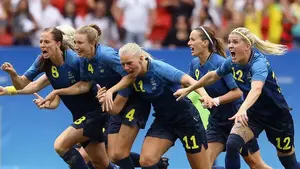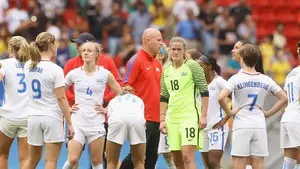There's a reason no team has claimed an Olympic gold medal the summer after winning the Women's World Cup. There's naturally the threat of complacency. Having a giant target on your back doesn't help either. And then luck factors into the equation.
Sure, a strong team can overcome any of those hurdles. But all of them at once? That would require something special.
As the U.S. national team fell to Sweden in the Olympic quarterfinals Friday, dropping a 4-3 decision on penalties after a 1-1 draw, the Americans' hopes of making history came to an unexpectedly swift end. Having appeared in the final of the first five women's Soccer tournaments at the Olympics — winning four gold medals and a silver — the U.S. will miss out on the podium entirely this time around.
So what did we learn from the U.S. squad's early exit in Brazil? Here are three key takeaways:
SWEDEN HAS THE USA'S NUMBER
**

Sometimes it can be that simple. This Sweden team was thoroughly disappointing in the group stage, sandwiching a 5-1 shellacking against Brazil between an unimpressive win over South Africa and a scoreless draw with China.
Yet there was always a sense that Sweden was going to give the U.S. all it could handle in Brasilia. Just look back to last summer's World Cup, when the Americans went 6-0-1 — with that draw coming against the Swedes in the group stage. Sweden didn't even win a game at that tournament, tying all three group matches before crashing out with a 4-1 loss to Germany in the round of 16.
There's something to be said for Sweden coach Pia Sundhage's familiarity with the U.S. roster after coaching the team from 2008 to 2012, as her defend-and-counter strategy seemed to leave the Americans thoroughly flummoxed. But let's not underestimate the fine line between success and failure in this sport. Remember how the U.S. defeated Germany in the World Cup semifinals largely thanks to Celia Sasic's missed penalty kick? Probably not — we all just remember Carli Lloyd's 16-minute hat trick against Japan five days later.
Just as the narrative of that World Cup dramatically shifted on one poorly taken penalty, the U.S. run at these Olympics was dictated on a series of split-second sequences. So please remember that any sweeping generalizations about the state of the U.S. program based off this match are inherently disingenuous.
THE AMERICANS WENT TOO DIRECT
**

All of that said, the American approach against Sweden left something to be desired. Abby Wambach may have retired in December, but when faced with a bunkered-in defense, this U.S. team still resorts to hopeful crosses at an alarming rate. While Lloyd can be lethal in the air, that's not exactly Alex Morgan's strong suit. Although the U.S. striker did pounce on a miscue to net the equalizer, you didn't see Morgan getting her head on much of anything Friday.
The shift to a 4-3-3 formation in the buildup to the Olympics was supposed to give the U.S. a more dynamic attack in Brazil. But the Americans never really found a groove in that look, with Allie Long merely serviceable as the deep-lying playmaker and Morgan Brian not at her influential best.
The shift to a 4-4-2, with speedster Crystal Dunn adding another option up top, allowed the U.S. to create better opportunities. Ultimately, though, coach Jill Ellis' squad was lacking the combination play and creative instincts necessary to break down its opponent.
THE FUTURE REMAINS BRIGHT
**

When searching for reasons why this U.S. team fell short, you can skip right past stagnation. This roster has gone through remarkable turnover over the past 13 months, moving on from veterans such as Wambach, Lauren Holiday and Christie Rampone and injecting the squad with the youthful likes of Dunn, Lindsey Horan and 18-year-old Mallory Pugh.
Three years will pass before the U.S. takes the field in another major tournament. For all that can happen in that time, Pugh, Dunn and Co. should have fans feeling confident that the Americans will be competing for another crown come the 2019 Women's World Cup in France.
..... - Goal******